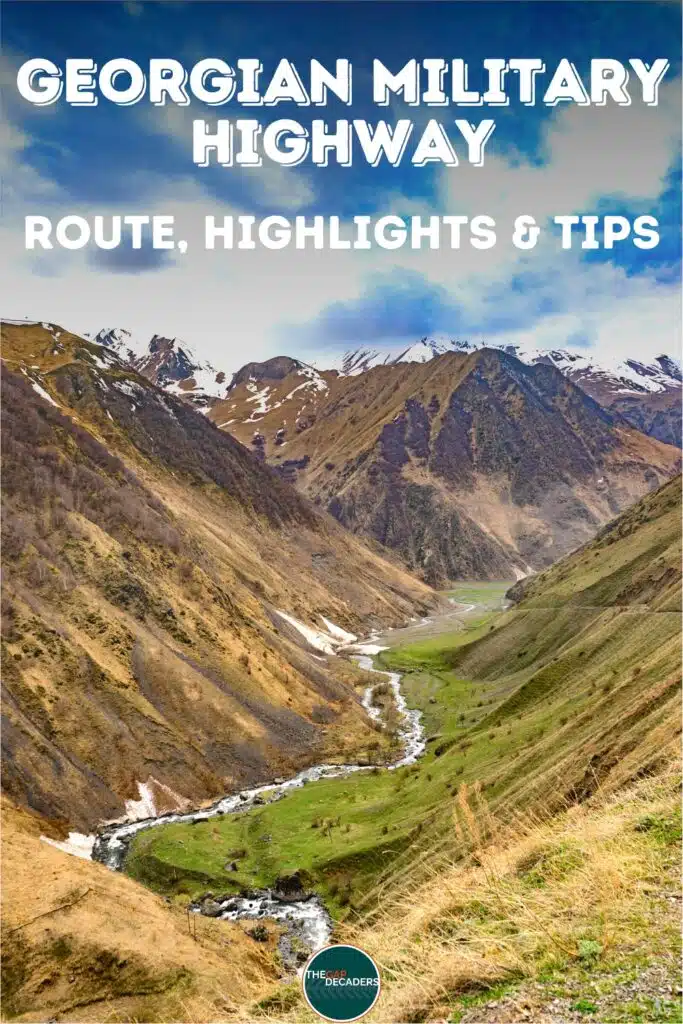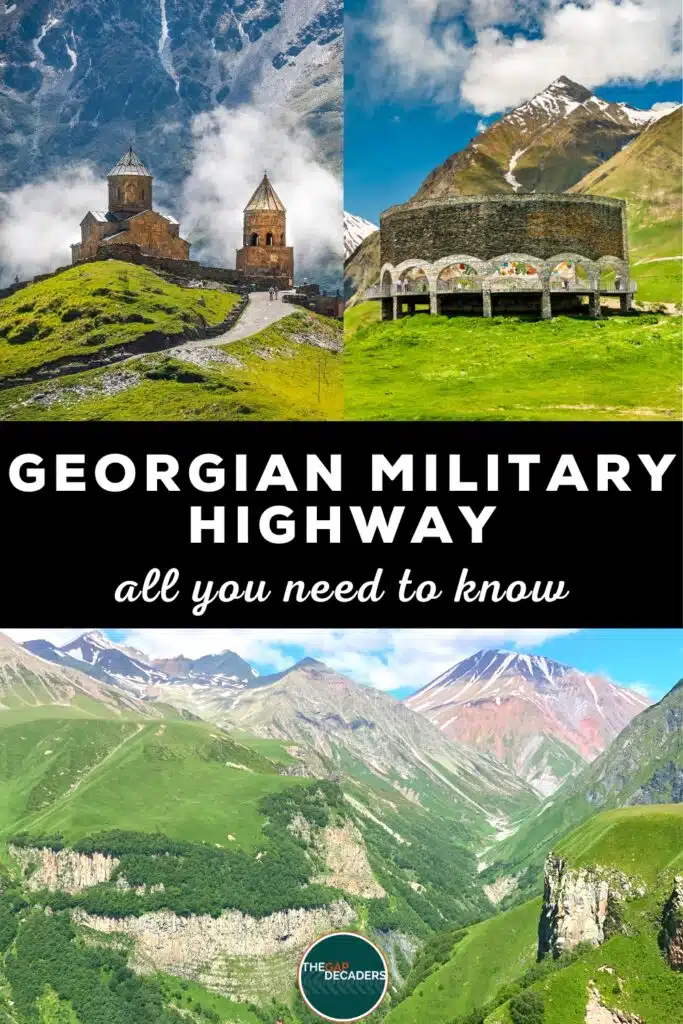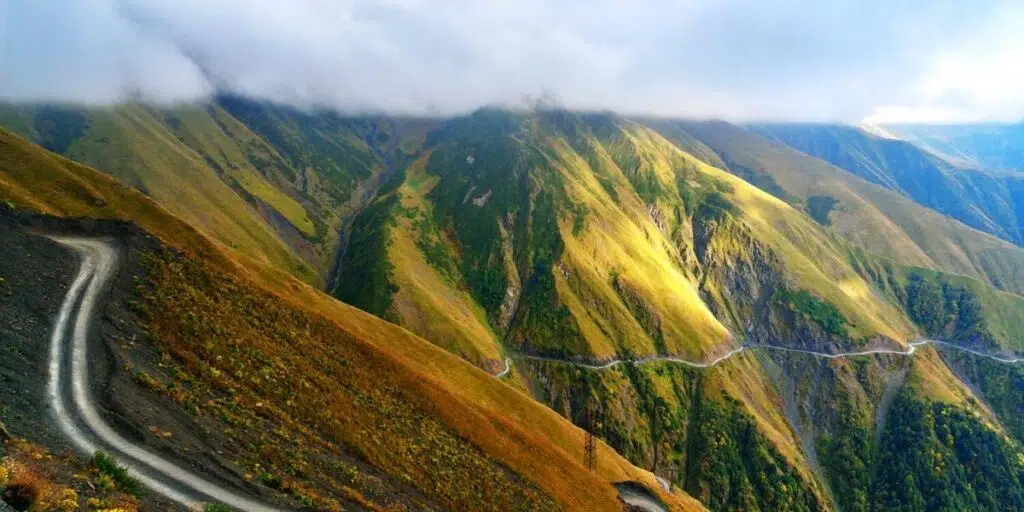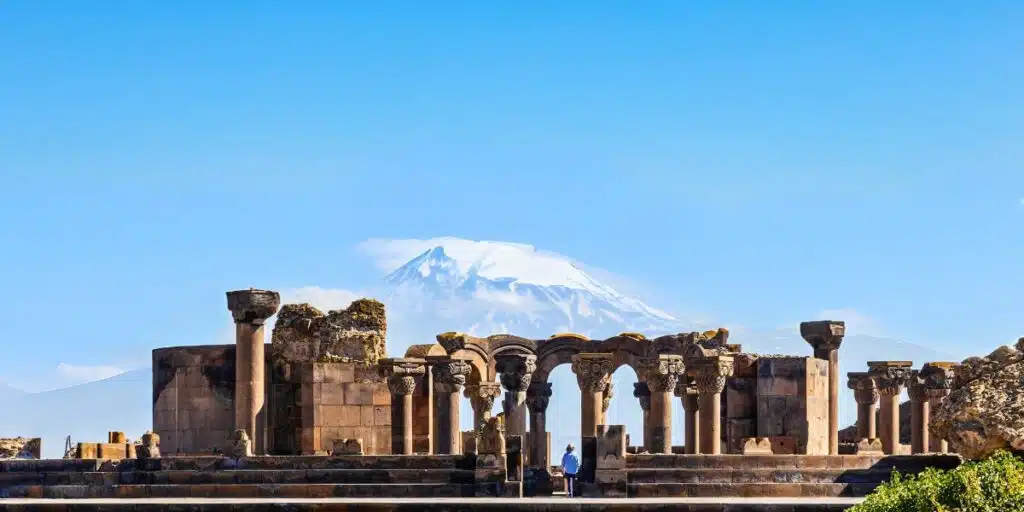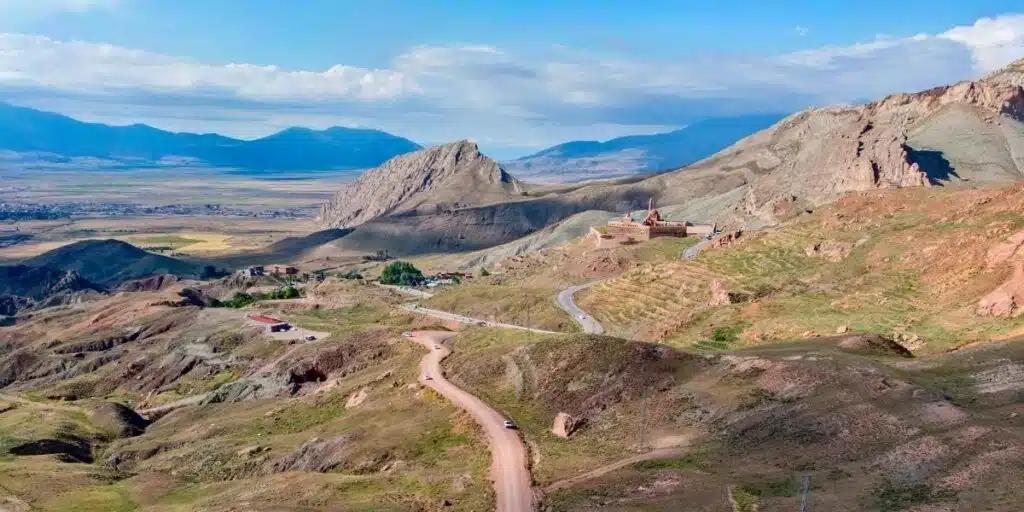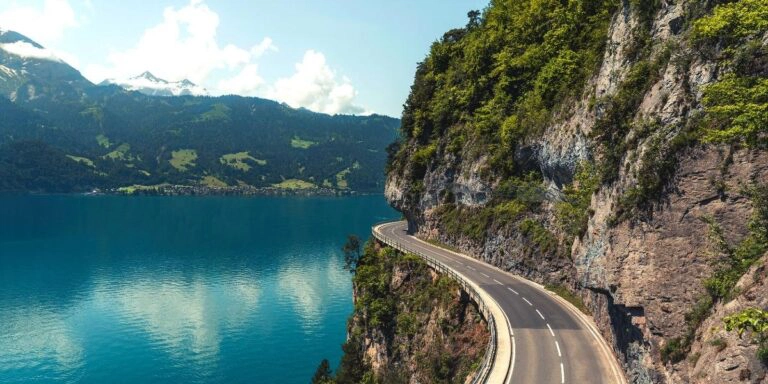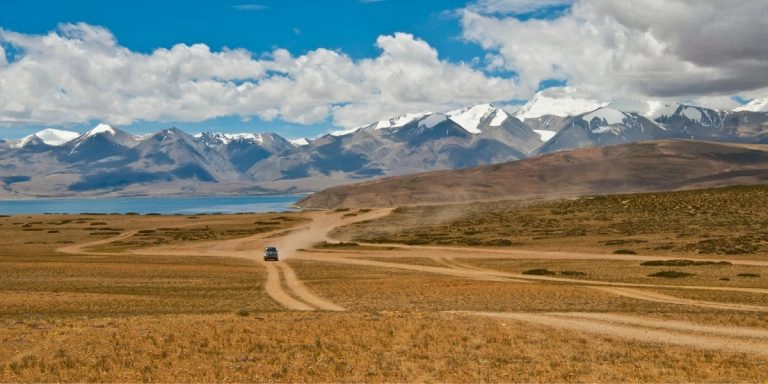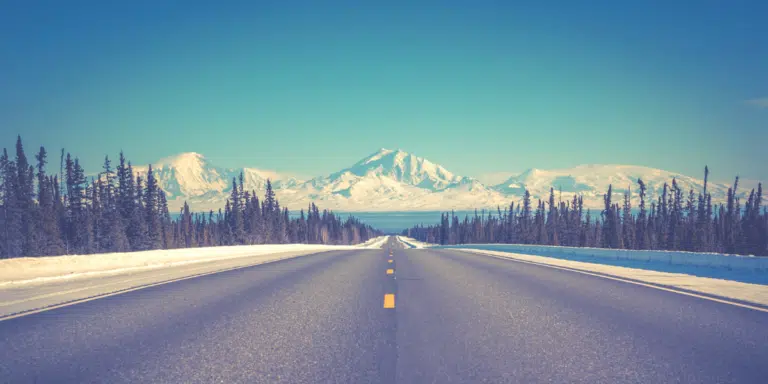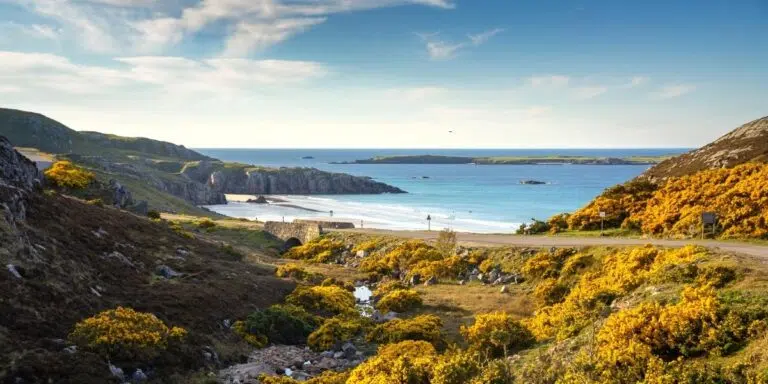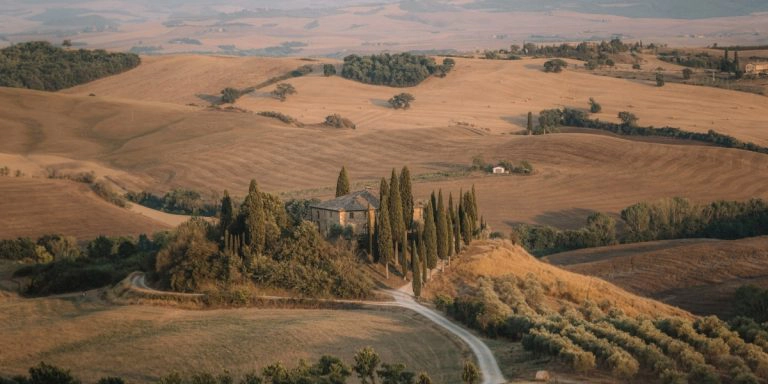This post may contain affiliate links, from which we earn an income. Click here to read our affiliate policy.
One of the most iconic road trips in Georgia, this ancient passage to Russia from Georgia’s capital city of Tbilisi is a real adventure and the road to Kazbegi is both spectacular and challenging.
Drive the Georgian Military Highway and you’ll be rewarded with several of Georgia’s must-see attractions en route surrounded by stupendous scenery, and be able to enjoy the kudos that comes with driving what is considered one of the world’s most dangerous roads.
Our Georgian Military Highway travel guide includes an interactive map with route, highlights and tips to help you plan an amazing Georgia Military Highway road trip.
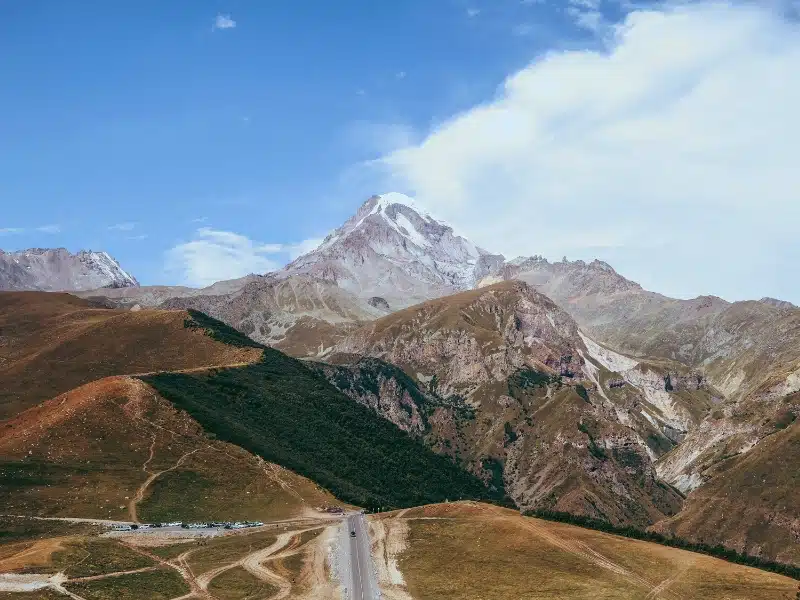
What is the Georgian Military Highway?
The iconic Georgian Military Road has existed since before the 1st century BCE, and in an incredible feat of man against nature, was converted into a proper carriage road in 1783.
In 1801, after the Russian Empire annexed the Kingdom of Georgia, Tsar Alexander I ordered General Aleksey Petrovich Yermolov, the commander-in-chief of Russian forces in the Caucasus, to improve the road surface to enable troop movement in the region.
By 1863 the road was being compared to the Simplon Pass in Switzerland, although improvements were still ongoing and work had racked up a spend of US$4.9 million (equivalent to US$40 million in 2022). But, the work was considered to be of a high quality and with two lanes and ‘iron bridges over the torrents’, was a major achievement as proper roads in Russia at the time were pretty much non-existent.
Since 2013, when Russia agreed to re-open its border with Georgia, this Transcaucasian highway has once again become a major freight route linking the Caucasus region with Russia.
The road, technically the E117, leaves the capital city of Tbilisi and slowly winds its way into the Greater Caucasus mountain range for 212 miles (186km) passing many famous landmarks and spectacular scenery along the way.
RELATED POST: Is Georgia a Safe Country? A Comprehensive Guide for Adventurous Travelers
Is this your first time visiting Georgia? Get all the information you need in our Georgia Travel Guide, including what to pack, the best time of year to go, getting there and practical tips to help you have the best trip!
How to Travel the Georgian Military Highway
Self-Drive
The Georgian Military Road is an easy enough drive but the changing road surfaces, frequent landslides and volume of freight traffic mean you need to be alert at all times, and for some people, this can detract from the drive and the surrounding spectacular scenery.
If that doesn’t phase you and you want the challenge of this iconic road, then driving yourself is the only way! You’ll have the flexibility of being able to travel at your own pace, stopping whenever and wherever you want to hop out and take photos or grab a coffee from a roadside stand.
Are you planning to rent a car in Georgia? We recommend hiring your car with Localrent.com, an aggregator of local car rental companies. They work with small car rental companies that only operate in their location and closely monitor the quality of their service. This means you get the best service for the lowest price.
For a real adventure, hire a campervan in Georgia. Overlando offer self-drive campervan trips with their fully equipped 4×4 campers, including the awesome (and very cute) UAZ Bukhanka, a Soviet classic named after a loaf of bread!
If you prefer a smaller vehicle, check out their Lada and Hilux cars with rooftop tents. You can park and sleep anywhere in Georgia, as long as you’re not on private land. Use the Park4Night app to find overnight spots, and sleep on a high mountain pass, next to a beautiful river or hot spring, or in a wildflower meadow.
Marshrutka to Kazbegi
Marshrutka are shared minivans which operate a bit like buses but on a loose schedule. Marshrutkas leave frequently for Kazbegi from the Didube bus station in Tbilisi and the journey takes about 3 to 4 hours. The cost is around US$10 for a one way trip.
Taxi to Kazbegi
Taxis are also available from Didube bus station in Tbilisi and you’ll see them with signs advertising their routes, or you can arrange a private car and driver. The trip takes around four hours one way and the drivers are usually happy to make a couple of photo stops along the route.
A seat in a shared taxi will cost around US$15, but you do have to wait for the rest of the seats to fill before departing. You can also book the whole car for US$65-75 (depending on your negotiating skills!).
Organised Georgian Military Highway Tours
If you’re short of time and want to see as much of Georgia as possible, an organised tour from Tbilisi is a great way to see the Georgian Military Road and all the must-see highlights along the route. These are a few of our highly-rated top picks!
The Georgian Military Highway in an Overland Truck
We traveled the Georgian Military Highway in our overland truck in July 2022. Watch us as we wend our way north over the high mountain passes through spectacular landscapes where we sleep overnight in an alpine meadow, encounter cows on the roads, and tackle the constant stream of trucks and other traffic on this amazing, but pretty intense, road.
Georgian Military Highway Map & Itinerary
Tbilisi – Mtskheta – Ananuri – Pasanauri – Gudauri – Jvari Pass – Kazbegi – Dariali
How to use this map – Use your fingers (or computer mouse) to zoom in and out. Click or touch the icons to get more info about a place, and click the arrow in the box top left to open the index. To add to your own Google Maps account, click the star next to the title of the map.
Mtskheta
Georgia’s former royal capital of Mtskheta is one of the oldest and most spiritual cities in Georgia, and to this day remains the headquarters of the Georgian Orthodox Church.
A charming town at the confluence of the Mtkvari and Aragvi rivers, Mtskheta is picturesque and the ancient churches and monasteries are recognised as one of Georgia’s four UNESCO World Heritage Sites due to their historical importance.
Must-sees are the Jvari Monastery which sits high on a hill overlooking the town, the Samtavro Convent and the stunning 11th century Svetitskhoveli Cathedral.
Mid-Range: mtskheta room 53 – Booking.com | Agoda
Budget: David Batoni Guest House – Booking.com | Agoda
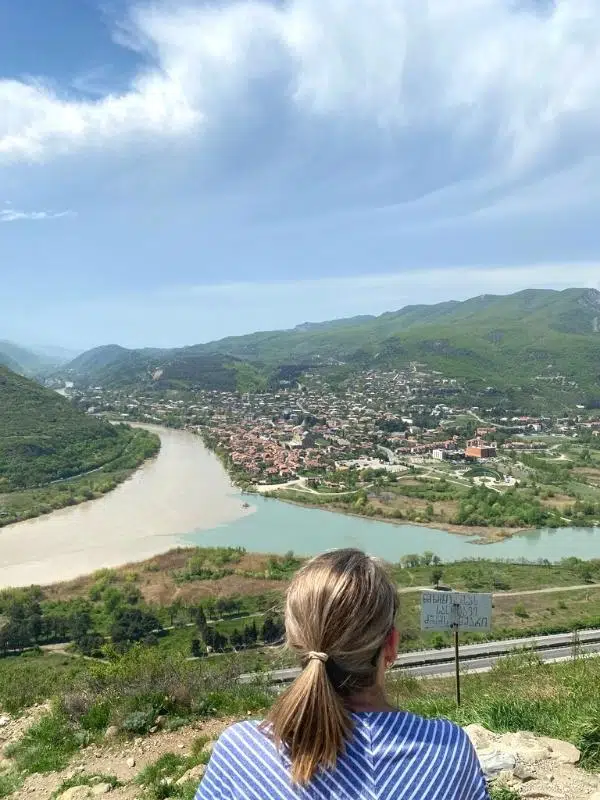
Prefer a quieter Georgian road trip adventure? Then head to Mestia, high in the Upper Svaneti region, for equally big mountains, fantastic hiking and spectacular scenery – without the traffic!
Zhinvali Reservoir Viewpoint
Make sure to stop at one of several viewpoints overlooking the sparkling turquoise Zhinvali Reservoir, such a bright and opaque colour due to all the minerals in the water. You’ll recognise the viewpoints because they have the typical large heart-shaped iron structures designed for you to frame your photo, which are common in Georgia.
Created in 1986 after the construction of a dam, the reservoir was contentious at the time of building as locals protested at the destruction of important archaeological sites. Regardless, the Soviets decided the need for water was greater and the valley was flooded, covering a village and the old route of the military highway.
You can see bits of the old road, its bridges and parts of the village when the water level is low, and sometimes, a tiny stone church can be spotted perching on the reservoir wall.
Just before the reservoir, at the confluence of two branches of the Aragvi River is the Monument of 300 Aragvians. Erected by the Soviets in 1959, the monument is dedicated to the fighters of the Aragvi Valley as they fought the invading Persian army and made their last stand at the Battle of Krtsanisi in 1795.
The Game of Thrones style tower, designed by architect A. Bakradze, is based on the tradition of the Caucasus mountains military tower architecture and inscribed around the central pole are words from a Vazha-Pshavela poem used as a resistance anthem during the Soviet times:
“We do not want to rob anyone’s homeland, but nobody can rob our homeland either from us, because we fight so fiercely for it, that even the dead will laugh at it.”
The Georgian Orthodox Church had the 300 Aragvians and those who fought and died in the battle canonized as martyrs in 2008.
RELATED POST: SIM Cards in Georgia: How to Buy + Best Deals
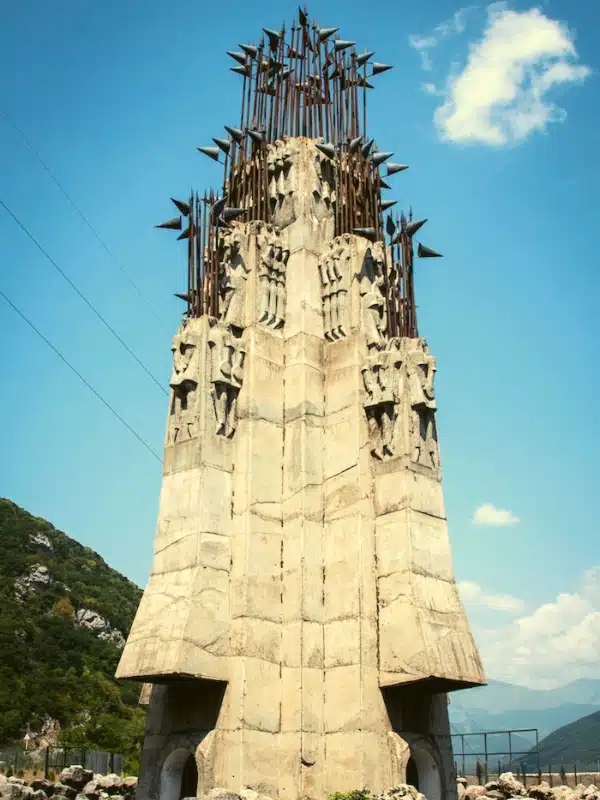
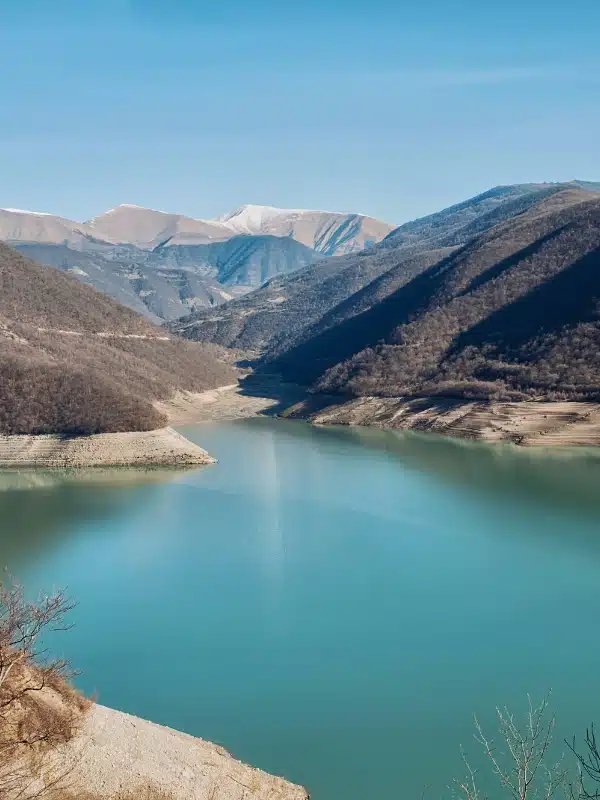
Don’t forget your road trip essentials! Our free road trip checklists help you remember everything, including road trip snacks, podcasts and road trip songs for the journey!
Ananuri Fortress Complex
Stop a little further along to see the 13th century Ananuri Fortress which sits high above the Zhinvali Reservoir. This historic walled site, which typifies Georgian religious buildings, includes a fortress, the silver-coned Church of the Mother of God, the Church of the Deity, the Mkurnali Church and a bell tower.
As you enter the castle complex through the gates set in the thick crenelated curtain wall, you’ll see an imposing stone wall covered in ancient Georgian script, an earlier version of the alphabet used today. Pick up a skirt and headscarf at the door of the 17th century Church of the Mother, where inside you’ll find beautiful frescoes.
Just before the roadside parking (which you have to pay for) is a road which leads down to Zhinvali lake, and a newly created park and picnic area. There is free parking, a few cafés, boats for rent and picnic tables, making it a great rest stop.
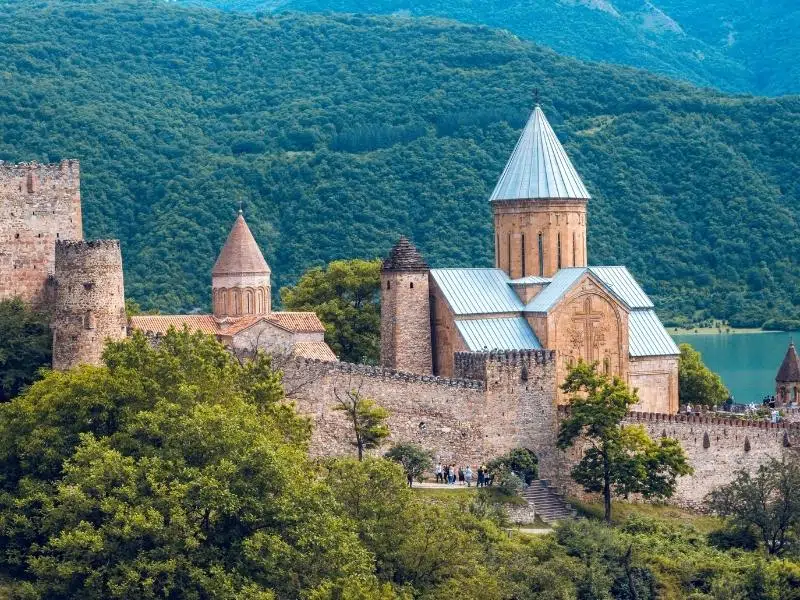
Pasanauri
Pasanauri is often called ‘the home of khinkali’, which are Georgian dumplings made of twisted knobs of dough stuffed with meat and spices.
Pasanauri is a great place to stop for lunch if you leave Tbilisi in the morning, and you should not only sample their delicious khinkali, but also their Imeretian khachapuri, a delicious bread stuffed with a salty local cheese called sulguni.
At the start of the village is the viewpoint for the so-called Aragvi River of two colors, caused by the origins of each river containing rocks of differing colors. The Tetri Aragvi, the ‘white’ river, flows from Gudauri down to the town of Pasanauri, where it is joined by the Shavi Aragvi, the ‘black’ river. From here the rivers join and flow along the Aragvi Gorge to the Zhinvali Reservoir.

Gudauri
After Kvemo Mleta the route starts to climb and you’ll ascend a switch-back road up the side of the mountain, with many hairpin bends, sheer drops and in places, a deteriorating road where the underpinning is being eroded.
Take it easy on this part of the road – large lorries struggle with the tight turns and you may encounter a tailback as vehicles wait to give the lorry drivers the full width of the road.
Georgia’s premier ski resort sits 2,192m above sea level and becomes a mountain playground in summer. You can go paragliding, horse riding and mountain biking, take out a quad bike and ride the cable car to Kobi, as well as hit the hiking trails around the local area.
Gudauri is a great place to base yourself for a few nights if you’re looking for mountain adventures.
Upmarket: Gudauri Lodge – Booking.com | Agoda
Mid-Range: Gudauri Loft Hotel – Booking.com | Agoda
Budget: New Gudauri Atrium Apartments – Booking.com | Agoda
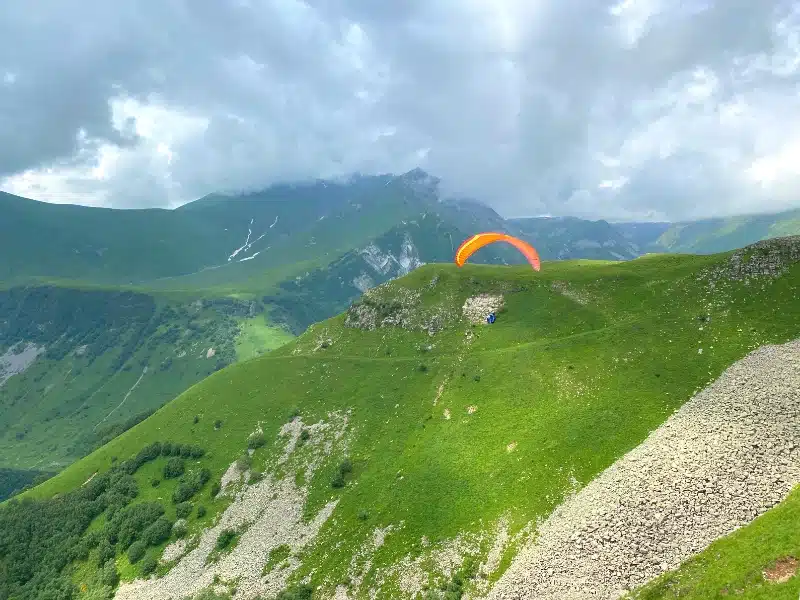
Russia-Georgia Friendship Monument
Between Gudauri and the Jvari Pass is the Russia Georgia Friendship Monument. This concrete behemoth was built in 1983 to celebrate the bicentennial of the Treaty of Georgievsk and the ongoing friendship between Soviet Georgia and Soviet Russia, which is ironic when you realise that just a few miles west is the border of the breakaway region of South Ossetia, annexed in 2008 and controlled by Russia.
The monument, designed by Georgian architect George Chakhava, is a huge round stone and concrete structure overlooking the breathtaking Devil’s Valley.
Inside the monument is a large and colorful tile mural by the artists Zurab Kapanadze, Zurab Lezhava and Nodar Malazoni, that spans the whole circumference of the structure and depicts scenes of Georgian and Russian history.
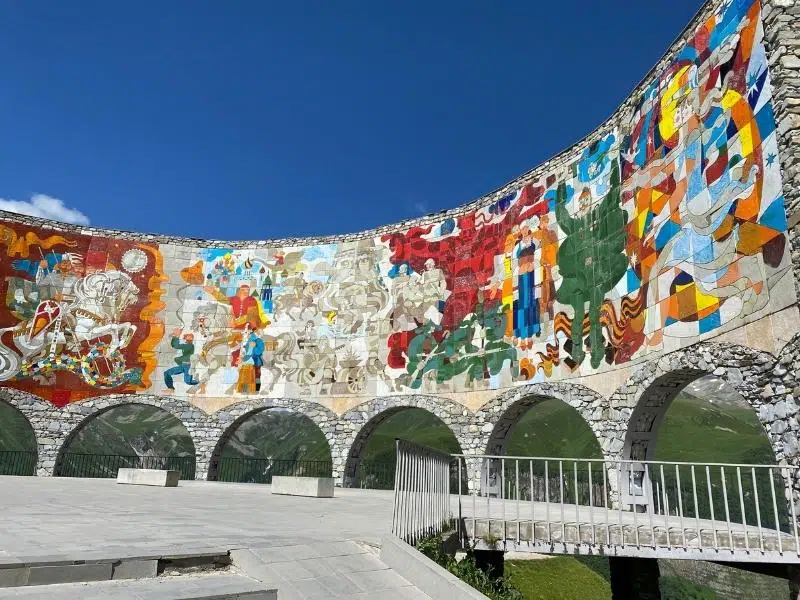
There are also spectacular views from the monument along the gorge, with the snaking silver Aragvi river and a round water reservoir on the valley floor hundreds of metres below.
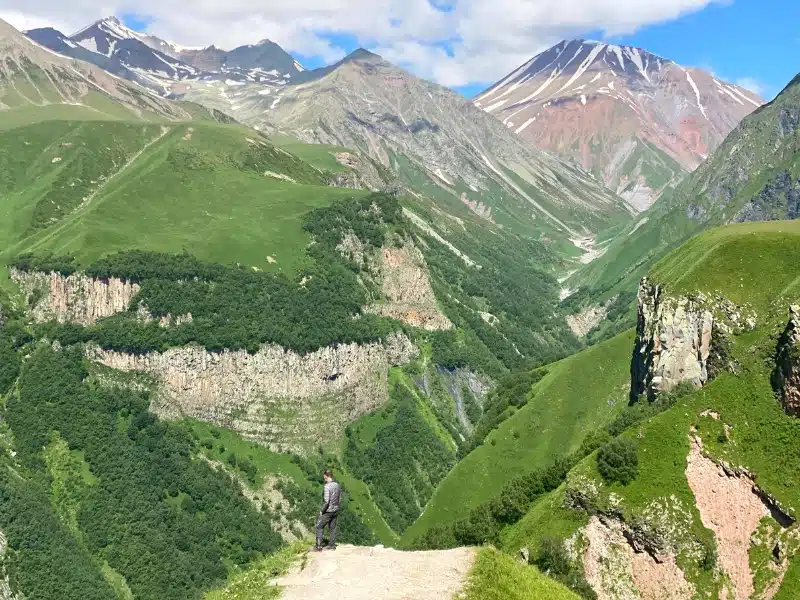
Other Nearby Road Trips
Jvari Pass
The Georgian Military Roads tops out at 2,395m above sea level at the Jvari Pass, also known as Krestovy Pereval or Cross Pass. An obelisk now marks the altitude, but the pass gets its name from a cross of red tuff stone which was erected by General Alexei Yermolov in 1824 to replace one originally placed there by King David the Builder.
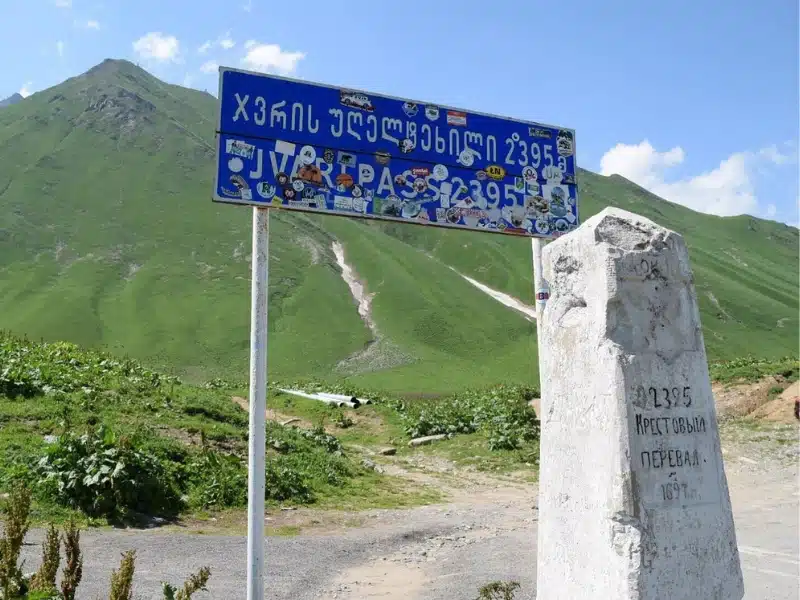
As you enter the pass, you really start to appreciate the might of the Caucasus mountains and the spectacular landscapes that surround you. Blanketed in snow or covered in verdant grass and wildflowers, this part of the drive will take your breath away.
At the top of the pass are stopping places where you can go for a horse ride into the mountains, drink tea and chacha, the fiercely potent Georgian pomace brandy, or get something to eat as you enjoy the surroundings.
There is also a German military cemetery – Deutscher Soldatenfriedhof – where a group of German POWs captured during World War II are buried, many of whom died as they were put to hard labour building the avalanche tunnels on the road.
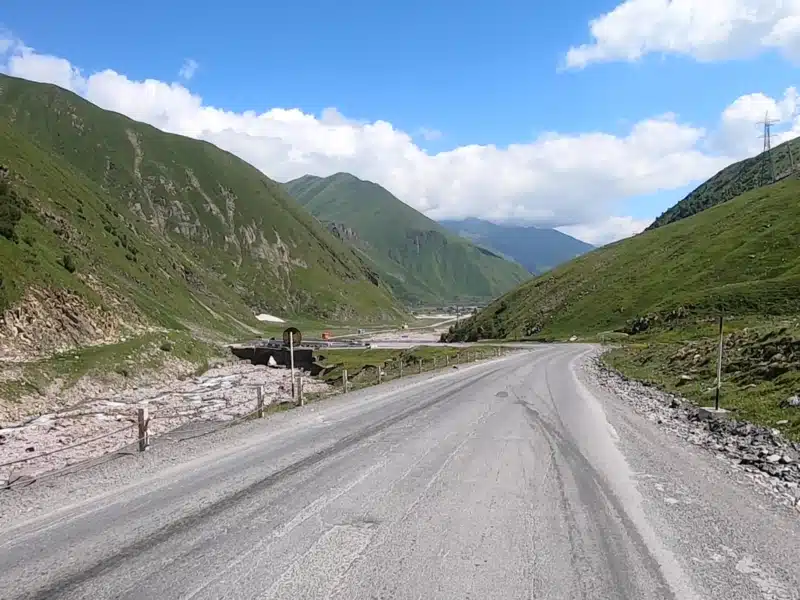
Travertine Mineral Springs
Hugging the road between the Jvari Pass and Almasiani are the travertine mineral springs, a curious natural phenomenon formed by the deposits of sulphur mineral springs, which leave behind limestone formations known as travertine. Water still flows down the travertines here which are part of the Kazbegi Protected Areas.
We found the bronze-coloured travertines a little underwhelming and it can be hard to stop here as parking is very limited. Just to make it harder, it’s on a bend in the road. If you can’t manage it going one way, try on the return!
There are plenty of other mineral water springs along the highway where you can stop and fill up your water bottle, or tank if you’re in a camper. Locals and tourists stop and fill their water bottles with the clean fresh mountain water, and on hot days you’ll see many dunking their heads under the outlets, and even cooling their feet!
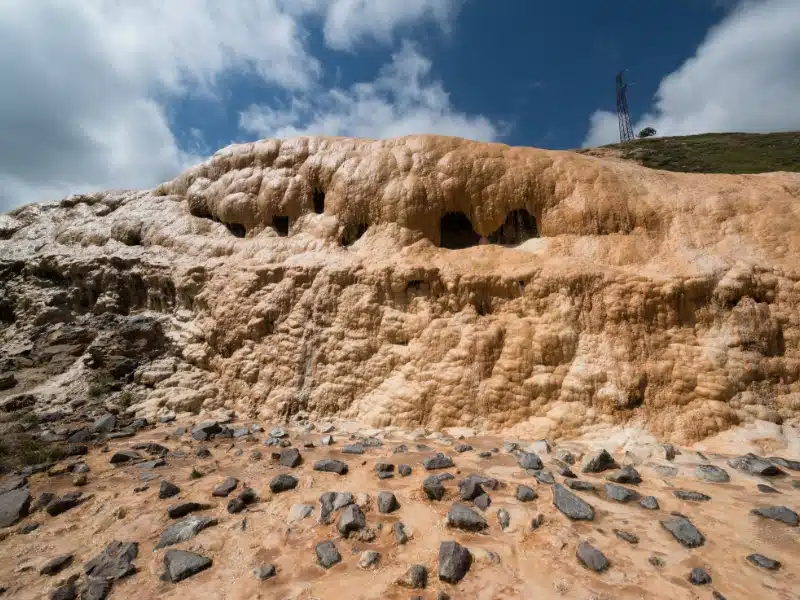
Kazbegi
Kazbegi (its Soviet name) also called Stepantsminda (its official name), is the last town before the Russian border. At the foot of the mighty 5,054m Mount Kazbek, the town is a popular stop on the route north.
Kazbegi makes the perfect base to explore the local area, and serious hikers will especially enjoy the Kazbegi Glacier and Gergeti Glacier. The homestays, guesthouses and hotels offer a warm welcome, as well as delicious homemade Georgian food.
Upmarket: Rooms Hotel Kazbegi – Booking.com | Agoda
Mid-Range: Kazbegi Targmani Cottages – Booking.com | Agoda
Budget: Vache Hotel – Booking.com | Agoda
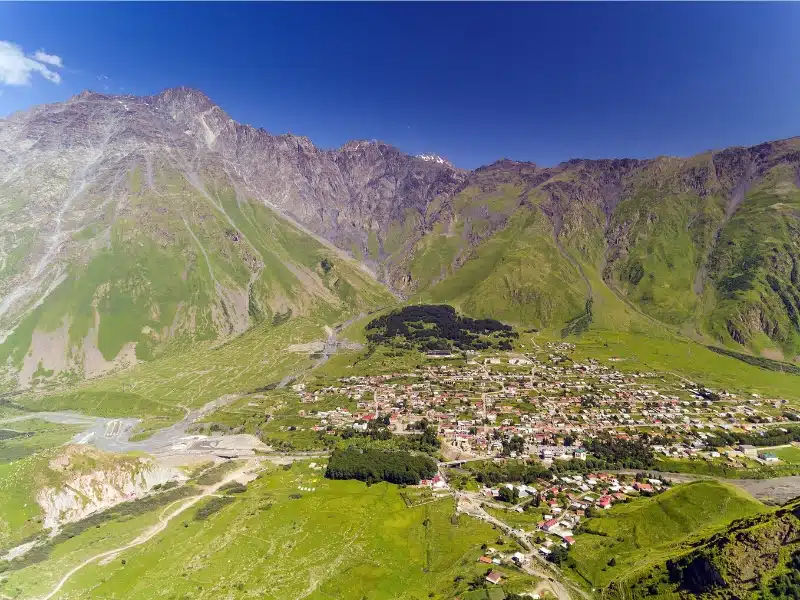
Side Trips from Kazbegi
Gergeti Trinity Church
The Gergeti Trinity Church is the town’s poster child, and deservedly so. A fairly unremarkable and typical Georgian church, it’s the location that adds the wow factor. Surrounded by the vast mountains of the Greater Caucasus, the church itself sits on a high plateau above the town, and is a photographer’s dream.
Although a brand new tarmac road was opened from Kazbegi up to the Gergeti Church in 2018, it is currently closed (2022) due to a ‘landslide’. But it’s fairly common knowledge that there is no landslide and the road is in good condition.
However, it’s more profitable for the local 4×4 taxi drivers to take visitors up at US$25 a time on the old road, a bone-rattling drive over makeshift bridges and badly rutted tracks. You just have to suck it up if you want to see the church and its incredible views.
You can also hike up to the church via the track that starts at the Gergeti Café and follows the Bashi River valley before climbing to the church from the south. It’s the longest route at 6.4km both ways, but also the least steep and furthest from the road.
If you don’t fancy the hike up, but want the views, head for St Eliah church to the east of Kazbegi, from where there is a stunning view of the Gergeti Trinity Church and Mount Kazbek.
The easy 5km walk to St Eliah and back climbs east from the village center and onto the hillside before arriving at the church. This vantage point offers picture postcard views and is worth the effort of the short hike.
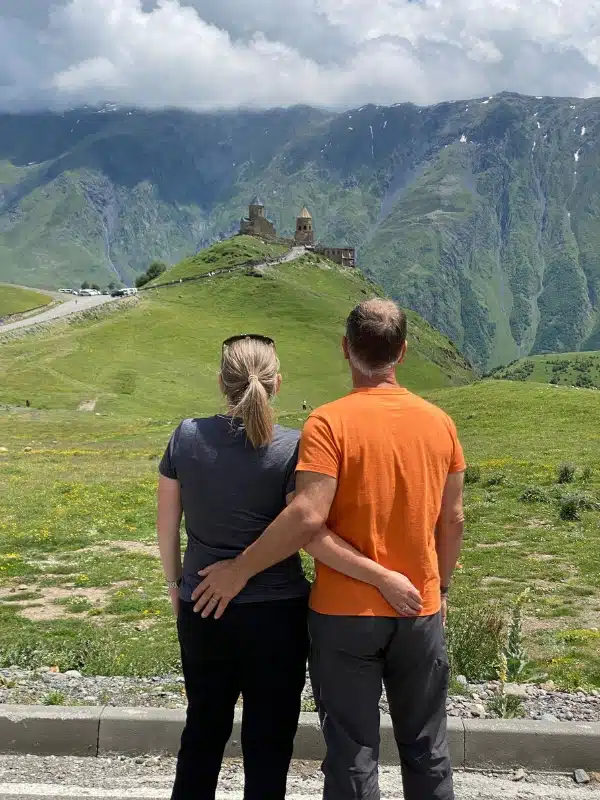
Truso Valley
The Truso Valley hike is relatively easy from a technical perspective and fairly flat, but at 22km there and back the trail is long, so you will need a certain degree of fitness.
You’ll pass mineral springs, a fast-flowing river with natural swimming pools and ancient watchtowers in abandoned villages before arriving at the Zakagori Fortress on the Suatisi River, making this one of the most magical hikes around Kazbegi.
The trailhead starts from Kvemo Okrokana, where you can also park your car, or get the daily Mountain Freaks shuttle bus from Kazbegi.
Sno
The village of Sno is a few kilometres east of the highway, at the entrance to the beautiful Sno Valley, and is known for its mineral water springs, being the home of the current head of the Georgian Orthodox Church, Sno Castle, and for its Gigantic Sculptures by local artist Merab Piranishvili.
The sculptures are of giant Easter Island style heads, carved out of granite and depicting an important person from Georgian history, and can be seen as you drive into the village on the winding Sno-Akhaltsikhe-Juta road.
Drive this road, or get the Mountain Freaks shuttle, to the scenic mountain village of Juta, the start point for a number of hikes including trekking beneath the Chauchi massif, known as the Georgian Dolomites, and the challenging trail to the Chaukhi Pass at 3431m above sea level.
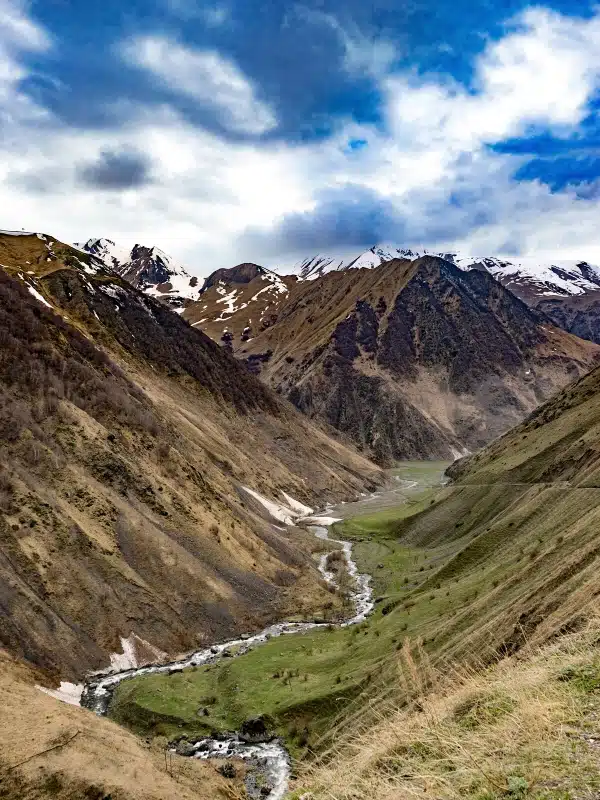
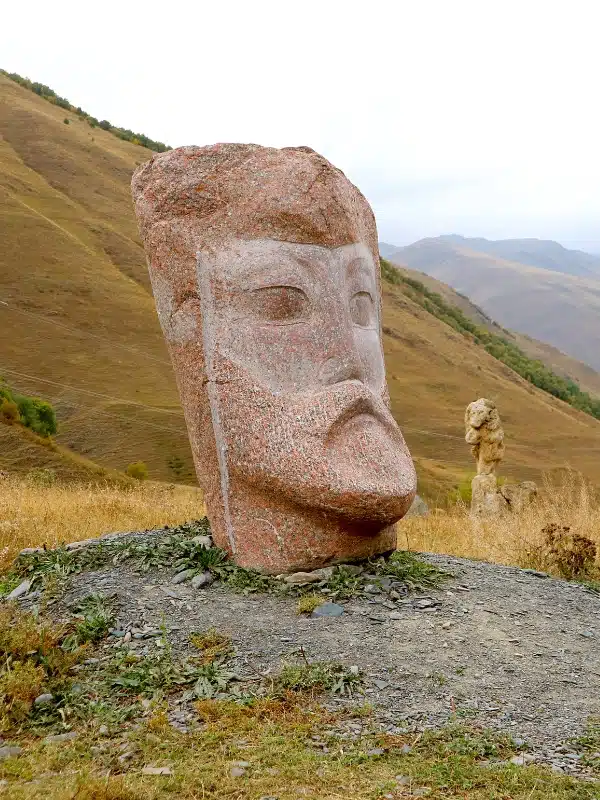
Gveleti Waterfalls
Between Kazbegi and Dariali is the parking lot for the Gveleti Waterfalls, a hidden gem an easy 30 minute hike from the road. If you’re planning to visit as a day trip from Kazbegi, Mountain Freaks provide a shuttle bus which also visits Tsdo village and the Dairaili monastery complex.
There is a big waterfall and a smaller waterfall, and the ruined Gveleti Tower to spot on the way. The name Gveleti means ‘place of snakes’, a reminder to be aware of the wildlife in this area, which also includes eagles, hawks, and Griffon vultures swooping through the steep valleys which surround this gorgeous spot.
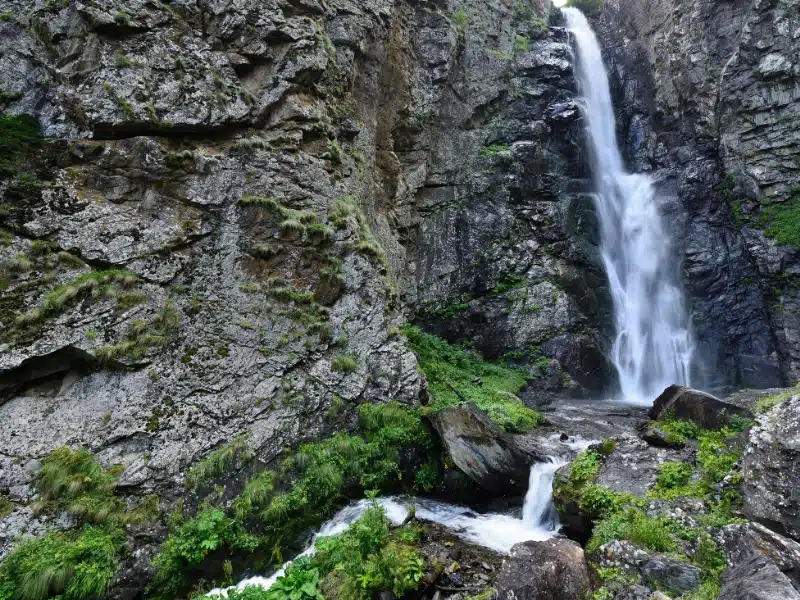
Dariali
The final few attractions before the Russian border, the 11km long Dariali Gorge and the huge Dariali monastery complex are both worth a stop before you head south again.
There is a convenient viewpoint for the Terek Valley and Dariali Gorge on the highway itself, which gives magnificent views over the Terek River and beyond to the Russian border.
From here, the road continues for less than a mile to the Kazbegi-Verkhni Lars border crossing before finishing at Vladikavkaz, the capital of Russia’s North Ossetia-Alania Oblast.
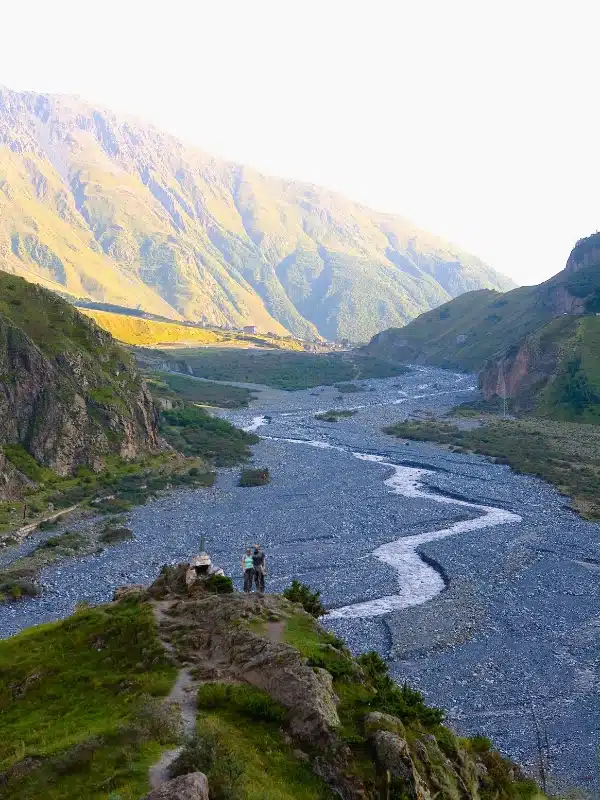
Georgian Military Highway FAQs
Do I need a 4×4 to drive the Georgian Military Highway?
You don’t need a special car to drive the Georgian Military Highway. We saw regular sedan cars, 4×4 MPVs and even a car towing a caravan.
You may prefer a 4WD car with good ground clearance in winter, it will make things a little easier and more comfortable in bad weather, but it’s not a necessity.
Is the Georgian Military Highway safe?
In as much as you won’t be robbed by highwaymen as you drive the route, yes the military road is safe.
However, the highway is considered one of the most dangerous roads in the world and you need to be aware that there may be inclement weather causing issues with the road, bad drivers, falling rocks and any other number of hazards which are unforeseen and to some extent, can’t be planned for.
To prepare for the trip and stay safe, follow these basic tips;
Make sure you have travel insurance you can trust when visiting Georgia. We recommend True Traveller for their 5-star TrustPilot reviews, variety of cover options, best activities cover as standard, great prices and excellent service.
Is there a lot of freight on the Georgian Military Road?
As you leave Mtskheta heading north, you’ll notice the first of a long line of trucks lining the asphalt at the side of the road. These trucks are waiting to start the route, but need permission from the Georgian Police who manage the movement of freight along the road.
You’ll see similar queues at strategic points as you go, and the controlled movement of freight means that the road is never grid-locked with traffic.
These Georgian Military Highway trucks not only come from the other Caucasus countries of Armenia and Azerbaijan, but from Turkey, Iran and the further afield Stans – the vast region stretching from the Caspian Sea to China. The suffix ‘stan is Persian and Urdu for ‘land of’.
Be mindful as you overtake these lines of lorries. Sometimes there is no verge or roadside, and the trucks encroach onto the highway. There is usually enough room on the remaining asphalt for two regular-sized cars to pass, but if you meet a large vehicle coming the other way (or you’re in a large vehicle like our overland truck), passing might be tight.
How long do I need to road trip the Georgian Military Road?
Although the actual drive time one way is just three hours (according to Google) we wouldn’t advise trying to do this trip in one day.
The likelihood of you actually getting from Tbilisi to Kazbegi in three hours is pretty low – by the time you’ve stopped to see stuff, tackled the road and freight traffic, dodged the animals along the route, and slowed down for balconies and tunnels, it’s more likely to be six hours!
We recommend four to five days to road trip the Georgian Military Highway to see all this unique road has to offer, and for time to explore the mountains, waterfalls, valleys, towns and churches of the region.
When should I drive the Georgian Military Highway?
Each time of year has its own special feel, with gorgeous wildflowers carpeting the alpine meadows in spring, lush landscapes and beautiful clear days in summer, golden colors in fall and of course, snow in winter, which gives an ethereal beauty to the landscape but can make for challenging driving conditions.
It is possible to drive the route year-round and a lot of effort goes into keeping the road open for freight between Georgia and Russia. However, heavy snow, avalanches and storms may mean parts of the road are closed with little notice, even though tunnels and balconies protect the most vulnerable areas.
The road may become unpassable for days at a time, whilst emergency repairs are carried out. When we traveled the Georgian Military Highway in July 2022, a huge storm took out a bridge on the route and traffic was baked up for 48 hours awaiting a temporary repair.
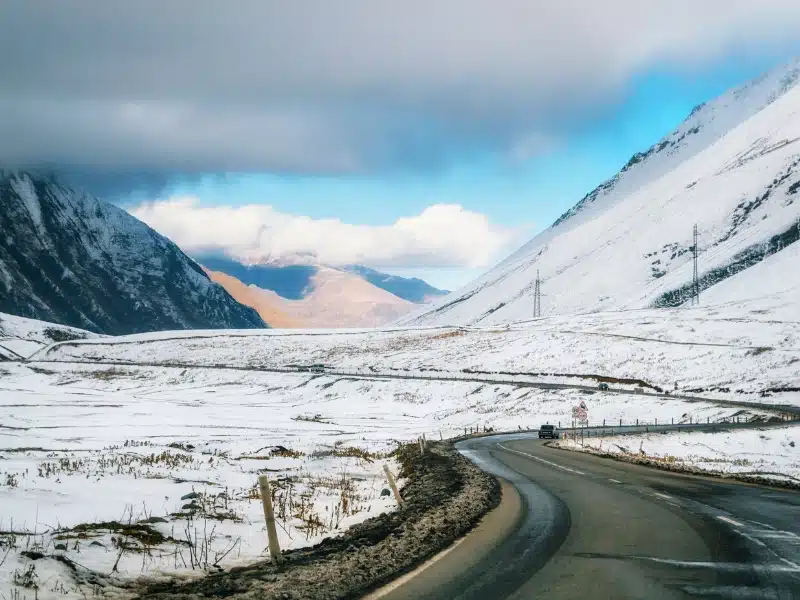
Georgia Essentials
Here are the websites and services we personally use and recommend for traveling in Georgia.
Looking for road trip inspiration? Check out these top posts…
Europe Road Trip: 25 Incredible Routes
Norway Road Trip: Four Unmissable Routes
Morocco Road Trip: An Epic Atlantic to Sahara Journey
Adventurous Road Trip – 26 of The World’s Most Exciting Routes
North Coast 500 Route Planner + Itinerary, Map & Tips
The Ultimate Bucket List Italy Road Trip
Love it? Pin it!
